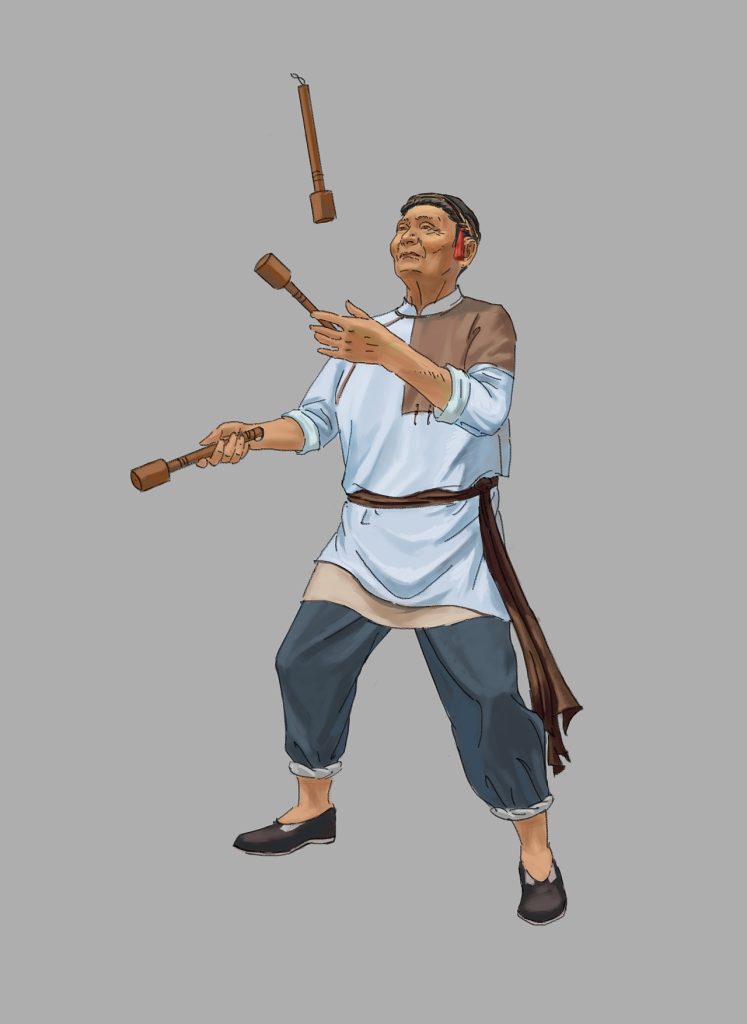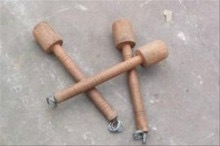The Wei Tang Da Lian Fa, also known as Wei Tang Acrobatics, is a traditional folk acrobatic performance art that originated in Weizhong Village, Weitang Street, Jiashan County. It is also considered a form of folk dance. The main props used in this performance are wooden mallets, approximately 30 centimeters long, called “hammers,” as well as knives, spears, forks, axes, and other metal implements or sticks. During the performance, the performers toss and catch these props, demonstrating various flexible and clever movements and tricks, accompanied by recitations and singing. Recitations mainly consist of tongue twisters, while the singing uses folk tunes. This performance form is both entertaining and serves as a form of exercise, and it was once a form of street performance by folk artists.
Basic Introduction to Wei Tang Da Lian Fa
Da Lian Fa is a traditional folk acrobatic performance art that originated in Weizhong Village, Weitang Street, Jiashan County. The prop used is a wooden mallet, approximately 30 centimeters long, called a “hammer” (the head of the hammer is 8 centimeters long and 6 centimeters in diameter, and the handle is 22 centimeters long). During the performance, the performer tosses and catches the wooden mallet, performing various tricks while singing or reciting corresponding phrases. Da Lian Fa has a long history. It is said that during the Southern Song Dynasty, when the Song army was defeated and retreated to Lin’an, there was a shortage of soldiers and food. Liu Wang, a small officer in the army, found that many soldiers in the army had the skill of tossing and catching weapons, so he came up with an idea to let them perform on the streets with their weapons. The way these soldiers played with weapons formed the prototype of Da Lian Fa. The officer named Liu Wang was later deified as a bodhisattva for his many good deeds, and he is revered as “Liu Wang Bodhisattva” and worshipped by people. Later, Da Lian Fa became a form of street performance by folk artists.

The content of Da Lian Fa performances can be divided into three categories: productive, such as “carrying water and holding babies,” “rolling up sleeves,” “removing boots,” “stacking rice piles,” “sifting bran,” “beating cloth and shaking cotton,” etc.; life-related, such as “washing face,” “painting eyebrows,” “combing hair and applying rouge,” etc.; and entertaining, such as “beauty kicking embroidered balls,” “catching dragonflies,” “bending wrists,” etc. Each type of performance has a special meaning. For example, in the performance of “carrying water and holding babies,” two hammers are tossed behind the back, and when caught, one hammer is placed in front of the chest, meaning to praise the intelligence and capability of young women who can carry water and hold babies at the same time. Each trick has good recitations, such as when performing “stacking rice piles,” the performer will sing and recite: “Stacking rice piles with knots, stacking rice piles with knots, from afar it’s dark, from near it’s shiny, this local grain is plentiful indeed. Well done! Yes, indeed!” meaning to praise the abundance of grain in this household. The better the recitation, the happier the praised host, and the more red envelopes they will give.
In the past, local artists used this skill as a means of livelihood, performing in villages during agricultural slack seasons, usually from the end of the twelfth lunar month to the end of March the following year. When traveling by boat, they would carry a cart with goods related to Liu Wang Bodhisattva’s family temple for performances along the way. Performers would dress themselves as horsemen or junior generals, wearing Daoist robes with red beards hanging on both sides. The performance would begin with gongs and drums, followed by good recitations, then the performance, with folk tunes interspersed throughout. Because Da Lian Fa involves both singing and acrobatic performances, as well as good recitations, it is very popular among the people. Often, families with weddings or building new houses would specially invite them to perform to add to the festivities.
Regarding the history of Wei Tang Da Lian Fa, there is a saying that it originated during the Southern Song Dynasty. At that time, when the Song army was defeated and retreated to Lin’an, there was a shortage of soldiers and food. A small officer named Liu Wang in the army found that many soldiers had the skill of tossing and catching weapons, so he let them perform on the streets with their weapons, which was the prototype of Da Lian Fa. Another saying is that the original name of Da Lian Fa was “Da Tong Chui.” Legend has it that hundreds of years ago, there was a general who used a copper hammer to drive away invading enemies. Later, in order to commemorate this patriotic hero, people would go to various places with small copper hammers to praise him. However, because the copper hammers were too heavy, they were later replaced with wood, and the name was changed to “Da Lian Fa.”

Wei Tang Da Lian Fa was once very popular in history, especially in the late Qing Dynasty and early Republic of China. However, as time passed, this form of performance gradually lost its former glory. In order to protect and inherit this intangible cultural heritage, local governments and cultural institutions have taken a series of measures for rescue protection, and encouraged older artists to pass on this skill to younger generations. Currently, Wei Tang Da Lian Fa has been included in the first batch of Jiashan City Intangible Cultural Heritage List, receiving more attention and protection.
Reference:
- “Wei Tang Da Lian Fa.” Jiashan News Network. [Accessed December 21, 2014].
